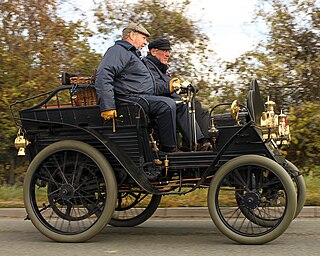Related Research Articles

Tiny was a British cyclecar manufactured by Nanson, Barker & Co at Esholt, Yorkshire between 1912 and 1915.

Bédélia was the archetype of the French cyclecars.

The Mors automobile factory was an early French car manufacturer. It was one of the first to take part in automobile racing, beginning in 1897, due to the belief of the company founder, Émile Mors, in racing's technical and promotional benefits. By the turn of the century, automobile racing had become largely a contest between Mors and Panhard et Levassor.
The Thrige was a Danish automobile manufactured in Odense between 1911 and 1917 by the Thomas B. Thrige company. The company was founded in 1894 and made electric motors.
The Baker & Dale was a British cyclecar manufactured in Southbourne, Sussex in 1913.

The Woodrow was a British cyclecar manufactured in Stockport from 1913 to 1915.
The Buckingham was an English automobile manufactured by the Buckingham Engineering Company in Coventry from 1914 until 1923. The company had made cars under the Chota name from 1912.

The Carden was a British 4 wheeled cyclecar made from 1914 by Carden Engineering originally based in Farnham, Surrey but moving in 1914 to Teddington, Middlesex and in 1919 to Ascot, Berkshire.
The Armstrong was a British 4-wheeled cyclecar made in 1913 and 1914 by the Armstrong Motor Company of Birmingham.
The Perry was a British car made by the Perry Motor Company based in Tyseley, Birmingham who made cars between 1913 and 1916.

The Warne was a British 4-wheeled cyclecar made from 1912 to 1915 by Pearsall Warne Ltd at the Icknield Works in Letchworth, Hertfordshire.
The Carlette was a British cyclecar made in 1913 by the Holstein Garage of Weybridge, Surrey.
The Dallison was an English cyclecar made in 1913 only by the Dallison Gearing and Motor Co Ltd based in Birmingham.

The Little Midland or LM was a British 4-wheeled cyclecar made from 1910 to 1922 by the Little Midland Light Car Co Ltd in various places in Lancashire.
The Zendik was a British cyclecar designed by Harold Birdsall Bullingham (1879-1952) and made by Zendik Cars Ltd of Thames Street, Kingston upon Thames, Surrey, England in 1912 and 1913. They had a sales office and showroom run by H Jenks at Ebury Street, Eaton Square, London SW.
YEC was a British motor car. Approximately 50 cars were manufactured in Sheffield from 1907–08.
Gordon, Gordon Cycle & Motor Company Ltd was a British manufacturer of bicycles and motor cars in 1903 and 1904. It was established on the Seven Sisters Road, north London.
Beacon Motors Ltd was a British automobile manufacturer based in Hindhead, Surrey from 1912-1913 moving to Liphook, Surrey until 1914.
The Day-Leeds was a British automobile manufactured by Job Day & Sons of Leeds, Yorkshire.

The Autocrat was a British car manufacturer operating from 1913 to 1926. The company operated from premises in the Balsall Heath area of Birmingham. Unusually for the time the company seems to have been run by two women, Ivy Rogers and Miss Howell.
References
- ↑ G.N. Georgano, N. (2000). Beaulieu Encyclopedia of the Automobile. London: HMSO. ISBN 1-57958-293-1.
- David Culshaw, Peter Horrobin: The Complete Catalogue of British Cars 1895-1975. Veloce Publishing plc, Dorchester 1997, ISBN 1-874105-93-6.
- Harald Linz, Halwart Schrader: Die Internationale Automobil-Enzyklopädie. United Soft Media Verlag, München 2008, ISBN 978-3-8032-9876-8.
- George Nick Georgano (Chefredakteur): The Beaulieu Encyclopedia of the Automobile. Volume 3: P–Z. Fitzroy Dearborn Publishers, Chicago 2001, ISBN 1-57958-293-1. (englisch)